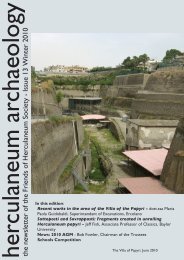herculaneum archaeology - The Friends of Herculaneum Society
herculaneum archaeology - The Friends of Herculaneum Society
herculaneum archaeology - The Friends of Herculaneum Society
Create successful ePaper yourself
Turn your PDF publications into a flip-book with our unique Google optimized e-Paper software.
OTHER NEWS<br />
Classicizing bronze statue <strong>of</strong> a girl adjusting<br />
her peplos, from the<br />
Villa <strong>of</strong> the Papyri at <strong>Herculaneum</strong>, Naples,<br />
Museo Archeologico Nazionale<br />
5619<br />
“Pompeii and the Roman Villa: Art and Culture around the Bay <strong>of</strong> Naples” opened at the National Gallery <strong>of</strong><br />
Art in Washington, DC, (October 2008 – March 2009) and traveled to the Los Angeles County Museum <strong>of</strong> Art (May – October<br />
2009) and to the Archaeological Museum <strong>of</strong> Mexico City (November 2009 – February 2010). Sculptures, paintings, mosaics, and<br />
luxury objects, both long-familiar works from <strong>Herculaneum</strong>, Pompeii, and Stabiae, and recent discoveries from Oplontis, Pozzuoli,<br />
and Moregine recalled the high culture <strong>of</strong> the coastal villas <strong>of</strong> Campania. 18th- and 19th-century books, paintings, sculptures,<br />
reproductions, and jewelry recorded the rediscovery and the impact <strong>of</strong> <strong>Herculaneum</strong> and Pompeii. Carol C. Mattusch <strong>of</strong> George<br />
Mason University conceived <strong>of</strong> and curated the exhibition, and is the principal author <strong>of</strong> the catalogue. She is a board-member <strong>of</strong><br />
the U.S. <strong>Friends</strong> <strong>of</strong> <strong>Herculaneum</strong> <strong>Society</strong>, as is Kenneth D. S. Lapatin, who took charge <strong>of</strong> “Pompeii and the Roman Villa” during its<br />
stay in Los Angeles.<br />
Visitors to the exhibition at the National Gallery <strong>of</strong> Art took a hypothetical tour <strong>of</strong> a magnificently appointed Roman villa,<br />
passing through the re-imagined atrium, tablinum, courtyard garden, and dining room, as well as a full-size re-creation <strong>of</strong> the exedra<br />
from the House <strong>of</strong> the Faun in Pompeii containing the Alexander mosaic. <strong>The</strong> décor in these rooms consisted <strong>of</strong> sculpture, relief,<br />
wall painting, fountain figures, silverware, lamp stands, jewelry, mosaic and opus sectile.<br />
<strong>The</strong> Archaeological Museum in Naples generously granted loans <strong>of</strong> a number <strong>of</strong> bronzes from the Villa dei Papiri which had<br />
never before left Naples: a lifesize bronze archaizing bust <strong>of</strong> a kouros (NM 5608); the most<br />
famous <strong>of</strong> five lifesize bronze statues <strong>of</strong> peplophoroi (NM 5619; fig.); a large bronze bust <strong>of</strong> a victorious youth (NM 5594); a small<br />
bust <strong>of</strong> Epicurus (NM 11017); and two bronze fountain-figures piped for water - a Silenus riding a wineskin (NM 5015) and a baby<br />
carrying a dolphin under one arm (NM 5021).<br />
Works from the town <strong>of</strong> <strong>Herculaneum</strong> included an exquisite drawing <strong>of</strong> a centauromachy on a Thasian marble plaque (NM<br />
9560); a rectangular Pentelic marble relief <strong>of</strong> Achilles and Telephos (NM 286787); a marble relief <strong>of</strong> a Dionysiac procession (NM<br />
6726); a delicate bronze statuette <strong>of</strong> Aphrodite wearing gold jewelry (NM 5133); the well-known bronze statuette <strong>of</strong> Alexander<br />
the Great on horseback (NM 4996); and a lifesize marble sculpture <strong>of</strong> a young woman (NM6248), one <strong>of</strong> the family-members <strong>of</strong><br />
<strong>Herculaneum</strong>’s great patron, Marcus Nonius Balbus.<br />
<strong>The</strong> eruptions <strong>of</strong> Mt. Vesuvius in AD 79 and then again during the eighteenth and nineteenth centuries formed the backdrop for<br />
the final section <strong>of</strong> the exhibition, concerning the rediscovery <strong>of</strong> Pompeii, <strong>Herculaneum</strong>, and Stabiae during the eighteenth century.<br />
<strong>The</strong> first formal excavations conducted anywhere in modern times began at <strong>Herculaneum</strong> in 1738, and at Pompeii ten years later.<br />
From the beginning, the work was documented, plans were drawn, and a scientific committee studied the finds and published 8<br />
volumes (1757-1792) entitled Delle Antichità di Ercolano, where the excavations had begun.<br />
Carol Mattusch Mathy Pr<strong>of</strong>essor <strong>of</strong> Art History, George Mason University<br />
For an exhibition nearer to home for most members, “Volcano: Turner to Warhol” runs until Sun 31<br />
October at Compton Verney in Warwickshire www.comptonverney.org.uk. “this is the first exhibition<br />
to celebrate the extraordinary artistic outpourings that volcanic eruptions have triggered over the<br />
past five centuries.”<br />
For more information about the <strong>Society</strong>, or if you have any comments, suggestions or ideas for<br />
articles for the next edition <strong>of</strong> <strong>Herculaneum</strong> Archaeology, please feel free to contact the editor. We<br />
hope you have enjoyed this edition, and thank you for your interest.<br />
Dirk Obbink - Editor<br />
Krystyna Cech - Production Editor<br />
<strong>The</strong> <strong>Friends</strong> <strong>of</strong> <strong>Herculaneum</strong> <strong>Society</strong>, <strong>The</strong> Ioannou Centre for Classical and Byzantine Studies,<br />
66 St Giles, Oxford OX1 3LU, United Kingdom<br />
Tel: (+44) (0) 1865 288260; Fax: (+44) (0) 1865 288386<br />
Email: <strong>herculaneum</strong>@classics.ox.ac.uk<br />
Website: http://www.<strong>herculaneum</strong>.ox.ac.uk/<br />
8



